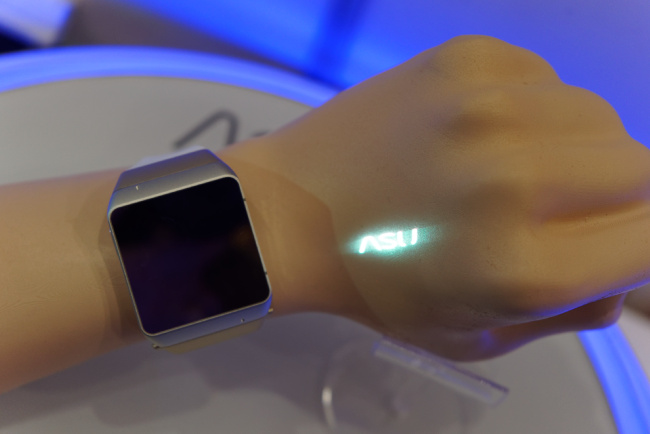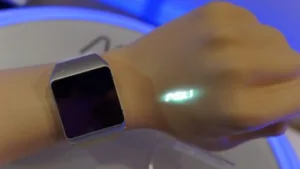We went along to the launch of a new “projection wearable” by Chinese company, ASU. The company made the launch alongside representatives from ST, Qualcomm, Foxconn and Amazon – an impressive lineup for a start-up.
The firm has developed a smartwatch that has an integrated pico-projector engine from ST. It is made by Foxconn and uses a Qualcomm chip, hence the big company support. It will be sold by a new Amazon division, headed by Jason Feldman, who was at the event, that is specialising in sales of products from start-ups and called Amazon LaunchPad and the ASU wearable will be one of the first items to be offered.
The ASU CastOne has a touch surface on the watch, but doesn’t have a display there – the projector is the only display. The light is projected onto the hand, which has to be be bent backwards to show the image. The projector is rated at 15 lumens, with 720p resolution, 5,000:1 contrast and 65K colours. The use of a laser light source means that focus is not needed. It has 4GB of memory and a Qualcomm processor.

The maximum image size is rated at 60″ and the watch can be mounted in an optional dock to provide connectivity and more power. The company imagines users having this available to whip out when they want to share images with others.
The company will start to ship the product in China in April, with deliveries starting in the US in June. 1,000 systems will be given away to developers and retail costs will be from $299 to $599.
Analyst Comment
I wanted to like this new product, it’s innovative and a new display technology, but it seems to me that the companies involved have been caught up in the enthusiasm of the firm’s CEO. The reality of the device is that many of the applications shown were quite impractical. There was a cycling application, for example, where to use the watch in its current form, the watch would need touch operation by one hand while the other hand was being bent at a very unrealistic angle – no practical cyclist would have any control of the bike under these circumstances. Another video from the firm shows a runner looking at a display on a running path. In daylight, with 15 lumens? I think not. Battery life would be minutes, as well, in this kind of application.
If the watch had an OLED on the watch surface as well, with the projector as an occasional option, then it might make more sense. For now, though, with only the projection display, I don’t see this product as more than a gimmick. (BR)

